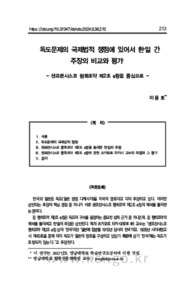

PARTNER
검증된 파트너 제휴사 자료
독도문제의 국제법적 쟁점에 있어서 한‧일 간 주장의 비교와 평가 - 샌프란시스코 평화조약 제2조 a항을 중심으로 - (Comparative Analysis and Evaluation of Korean and Japanese Claims on the Issues of International Law in the Dokdo Problem – With emphasis on Article 2 (a) of the San Francisco Peace Treaty)
34 페이지
최초등록일 2025.05.21
최종저작일
2024.06

-
미리보기
서지정보
· 발행기관 : 영남대학교 독도연구소
· 수록지 정보 : 독도연구 / 36호 / 213 ~ 246페이지
· 저자명 : 이용호
초록
한국과 일본은 독도(일본 명칭 다케시마)를 자국의 영토라고 각각 주장하고 있다. 이러한 상반되는 주장의 핵심 쟁점 중 하나가 바로 샌프란시스코 평화조약 제2조 a항의 해석을 둘러싼 논쟁이다.
동 평화조약 제2조 a항은 독도의 귀속을 결정하는 중요한 법적 근거 중 하나인데, 동 평화조약의 해석을 둘러싸고 한‧일의 주장은 상반된다. 특히 츠카모토 타카시(塚本 孝) 교수는 “샌프란시스코 평화조약 제2조 a항 상의 ‘한국’이란 ‘일본에 합병될 1910년 당시의 한국’이고, 1905년 시마네현고시 제40호를 통해 이미 독도가 일본의 영토를 구성하고 있었기 때문에 상기 ‘한국’에는 독도가 포함되지 않는다.”고 주장한다.
따라서 본 논문에서는 샌프란시스코 평화조약 제2조 a항의 해석을 둘러싼 한‧일의 주장을 소개하고, 특히 츠카모토 교수의 주장을 평가해 보고자 한다.
이상과 같은 평가를 통해, 본 논문은 다음과 같은 결론에 도달하였다.
먼저 츠카모토 교수의 주장은 카이로 선언, 포츠담 선언, 연합국최고사령부각서 제677호 등 일본영토를 결정했던 일련의 선행문서에 비추어 볼 때, 합리적 주장이라고 보기 어렵다. 또한 ‘일본영역도’ 내지 ‘일본영역참고도’ 등 동 평화조약 전후의 각종 문서와도 모순됨을 확인할 수 있었다.
둘째 동 평화조약 제2조 a항 상의 ‘한국’의 의미를 ‘1910년 합병 당시의 한국’이라는 주장과 관련해서도 “역사를 잊은 민족은 미래가 없다.”라는 문장으로 대응하고자 한다. ‘1904년 한‧일의정서’ 등을 통해 한국의 외교권을 장악한 상태에서 이루어진 1905년 시마네현고시 제40호는 국제법상 무효이며 불법행위이다. 따라서 1905년부터 독도가 일본의 영토였다고 하는 츠카모토 교수의 주장은 설득력이 없다.
셋째 동 평화조약의 체결과정에서 독도가 일본영토라는 근거로 제시하는 츠카모토 교수의 주장도 일본에게 유리한 문서만을 수합한 것으로서, 그와 반대되는 다양한 문서가 다수 존재한다는 점에서, 향후 국제재판에서 그 유용성을 인정받을 수 있는지의 여부는 불분명하다.
이처럼 동 평화조약 제2조 a항에 입각한 독도의 귀속문제는 한국과 일본이 각각 상반되는 입장을 보였으며, 양국의 이견만 확인한 셈이 되었다. 특히 츠카모토 교수의 주장도 결정적인 근거를 제공하였다기보다는 종래의 일본의 입장을 반복한 정도라고 평가할 수 있다.
이러한 관점에서 한국은 독도를 영원한 금수강산으로 후대에 물려줄 수 있도록 만전을 기해야 할 것이다. 이를 위해 실리외교 등을 통해 한국은 스스로 국력을 크게 키워 세계 일등국가로 나아가야 할 것이며, 동시에 독도가 국민적 사랑 가운데 항상 자리할 수 있도록 독도 교육과 홍보에 최선을 다하여야 할 것이다.영어초록
South Korea and Japan each claim Dokdo (known as Takeshima in Japan) as their territory. One of the main contentions in the Dokdo issues is the interpretation of Article 2(a) of the San Francisco Peace Treaty, which serves as one of the key legal bases for determining the sovereignty of Dokdo. The interpretation of the Treaty itself has led to diverging claims between South Korea and Japan. Professor Tsukamoto Takashi specifically argues that ‘Korea’ in Article 2(a) of the San Francisco Peace Treaty refers to ‘Korea at the time of its annexation by Japan in 1910’ and that since Dokdo was already part of Japan's territory due to the Shimane Prefecture Public Notice No. 40(1905), Dokdo is not included in “Korea” mentioned in the clause.
Therefore, this study aims to introduce and evaluate the conflicting claims of South Korea and Japan over the interpretation of Article 2(a) of the San Francisco Peace Treaty, particularly focusing on the claims made by Professor Tsukamoto. Through evaluations, this paper has reached the following conclusions: First, Professor Tsukamoto's claims are difficult to see as rational when reviewed against the backdrop of preceding documents like the Cairo Declaration, the Potsdam Declaration, and SCAPIN No. 677, which decided the territory of Japan. Also, it was found to be contradictory to various documents issued before or after the Peace Treaty such as ‘Map of Japan’s Territory in 1952’and‘Japanese Territory Reference Map in 1951’.
Second, regarding the argument that ‘Korea’ in Article 2(a) refers to ‘Korea at the time of the 1910 annexation’, emphasizing the declaration that "A nation that forgets its history has no future" applies here. The 1905 Shimane Prefecture Public Notice No. 40, issued while Korea's diplomatic rights were controlled following the 1904 Korea-Japan Protocol, is invalid and illegal under international law. Thus, Professor Tsukamoto's claim that Dokdo has been Japanese territory since 1905 lacks persuasion.
Third, Professor Tsukamoto's suggestion that Dokdo was considered Japanese territory in the process of negotiating the Peace Treaty, based merely on documents favorable to Japan, is also questionable. The existence of various other documents supporting the opposite claim makes its utility in future international litigations uncertain.
The issue of sovereignty over Dokdo viewed through Article 2(a) of the San Francisco Peace Treaty reveals that South Korea and Japan have maintained conflicting positions, effectively only confirming the divergence between the two countries. Professor Tsukamoto’s claims, rather than providing conclusive evidence, offer arguments that could be derived from the previous Japanese stance.
From this perspective, it is recommended that South Korea should be fully prepared to ensure that Dokdo remains a cherished and pristine natural heritage for future generations. Through diplomatic and practical efforts, South Korea should aim to enhance national strength and move towards becoming a prominent global nation, while ensuring that Dokdo is forever cherished in the hearts of its people through education and promotional activities.참고자료
· 없음태그
-
자주묻는질문의 답변을 확인해 주세요

꼭 알아주세요
-
자료의 정보 및 내용의 진실성에 대하여 해피캠퍼스는 보증하지 않으며, 해당 정보 및 게시물 저작권과 기타 법적 책임은 자료 등록자에게 있습니다.
자료 및 게시물 내용의 불법적 이용, 무단 전재∙배포는 금지되어 있습니다.
저작권침해, 명예훼손 등 분쟁 요소 발견 시 고객센터의 저작권침해 신고센터를 이용해 주시기 바랍니다. -
해피캠퍼스는 구매자와 판매자 모두가 만족하는 서비스가 되도록 노력하고 있으며, 아래의 4가지 자료환불 조건을 꼭 확인해주시기 바랍니다.
파일오류 중복자료 저작권 없음 설명과 실제 내용 불일치 파일의 다운로드가 제대로 되지 않거나 파일형식에 맞는 프로그램으로 정상 작동하지 않는 경우 다른 자료와 70% 이상 내용이 일치하는 경우 (중복임을 확인할 수 있는 근거 필요함) 인터넷의 다른 사이트, 연구기관, 학교, 서적 등의 자료를 도용한 경우 자료의 설명과 실제 자료의 내용이 일치하지 않는 경우
문서 초안을 생성해주는 EasyAI
